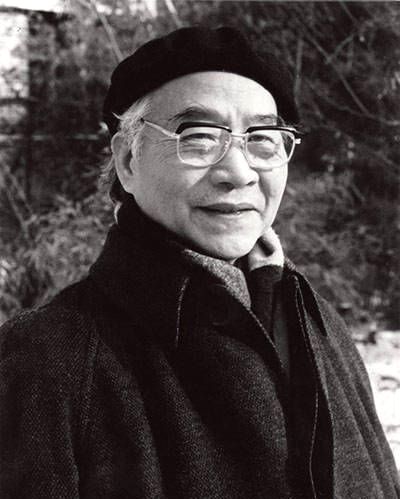
院长:吴作人
吴作人,安徽省泾县人,1908年生于江苏省苏州市,在那里度过了他的童少年时代。1926年入苏州工业专科学校建筑系,1927年至1930年初先后就读于上海艺术大学、南国艺术学院美术系及南京中央大学艺术系,从师著名画家徐悲鸿先生,并参加南国革新运动。早年攻素描油画,功力深厚,间作国画富于生活情趣,不落传统窠臼。晚年后专攻国画,境界开阔,寓意深远,以凝练而准确的形象融会著中西艺术的深厚造诣。他的艺术成就是多方面的。在素描、油画、艺术教育方面都造诣甚深,他在中国画创造方面更是别创一格,自成一家。1997年——4月9日在北京逝世。
1930年赴欧洲学习,先入巴黎高等美术学校,后考入比利时布鲁塞尔王家美术学院白思天院长画室学习。入学第二年即在全院暑期油画大会考中获金奖和桂冠生荣誉,他勤奋学习,掌握了熟练的专业技能,创作了数量可观的油画作品,表现出非凡的艺术才能。白思天院长称赞他“既不是弗拉曼画派,又不是中国传统,用乃是充满个性的作者”,1935年回国在中央大学艺术系任教,抗战期间随校西迁重庆。1938年率“战地写生团”赴前方作画。1943年至1944年赴陕甘青地区写生、临摹敦煌壁画。1944年至1945年初赴康藏高原,深入少数民族地区,写各色风貌,作大量写生画,举行多次展览。1946年任国立北平艺专教授兼教务主任并当选北平美术作家协会理事长。1947年先后在英国、法国、瑞士举办画展。1950年任中央美术学院教授兼教务长,1955年任副院长,1958年出任院长,1979年任名誉院长。曾当选中国美术家协会常务理事、副主席。1979年当选中国文联副主席,1985年当选中国美术家协会主席。曾连续当选第一至第六届全国人大代表。1984年法国政府文化部授予他“艺术与文学最高勋章”,1985年荣获比利时王国王冠级荣誉勋章。
Wu Zuoren, from Jing County, Anhui Province, was born in Suzhou, Jiangsu Province in 1908 and spent his childhood there. In 1926, he enrolled in the Architecture Department of Suzhou Industrial College. From 1927 to early 1930, he studied at Shanghai University of the Arts, the Fine Arts Department of Nanguo Academy of Arts, and the Art Department of Nanjing Central University, under the famous painter Mr. Xu Beihong, and participated in the Nanguo Reform Movement. In his early years, he focused on sketching and oil painting, with profound skills. He occasionally created traditional Chinese paintings that were rich in daily life and did not fall into the traditional mold. In his later years, he specialized in traditional Chinese painting, with a broad realm and profound meaning. He integrated the profound knowledge of Chinese and Western art with concise and accurate images. His artistic achievements are multifaceted. He has profound expertise in sketching, oil painting, and art education, and is particularly unique in the creation of Chinese painting, creating his own style. He passed away in Beijing on April 9th, 1997.
In 1930, he went to Europe to study, first attending the É cole des Beaux Arts in Paris, and later studying at the studio of Dean Bai Sitian of the Royal Academy of Fine Arts in Brussels, Belgium. In his second year of enrollment, he won a gold medal and the honor of being a crowned student in the summer oil painting examination of the entire college. He studied diligently, mastered proficient professional skills, and created a considerable number of oil paintings, demonstrating extraordinary artistic talent. Dean Bai Sitian praised him as "neither a Flemish school nor a traditional Chinese artist, but a writer full of personality." In 1935, he returned to China and taught at the Art Department of Central University. During the Anti Japanese War, he moved westward with the school to Chongqing. In 1938, he led the "Battlefield Sketching Team" to the front to paint. From 1943 to 1944, he went to the Shaanxi Gansu Qinghai region to sketch and copy Dunhuang murals. From 1944 to early 1945, he went to the Kangzang Plateau, delved into ethnic minority areas, wrote various styles, created a large number of sketches, and held multiple exhibitions. In 1946, he became a professor and academic director at the National Beiping Art College and was elected as the chairman of the Beiping Art Writers Association. In 1947, art exhibitions were held successively in England, France, and Switzerland. In 1950, he was appointed as a professor and dean of the Central Academy of Fine Arts. In 1955, he became the vice dean, in 1958 he became the dean, and in 1979 he became the honorary dean. Elected as Executive Director and Vice Chairman of the China Artists Association. In 1979, he was elected as the Vice Chairman of the China Federation of Literary and Art Circles, and in 1985, he was elected as the Chairman of the China Artists Association. He was successively elected as a deputy to the first to sixth National People's Congress. In 1984, the French Ministry of Culture awarded him the "Highest Order of Arts and Literature", and in 1985, he was awarded the Royal Order of Honour of the Kingdom of Belgium.